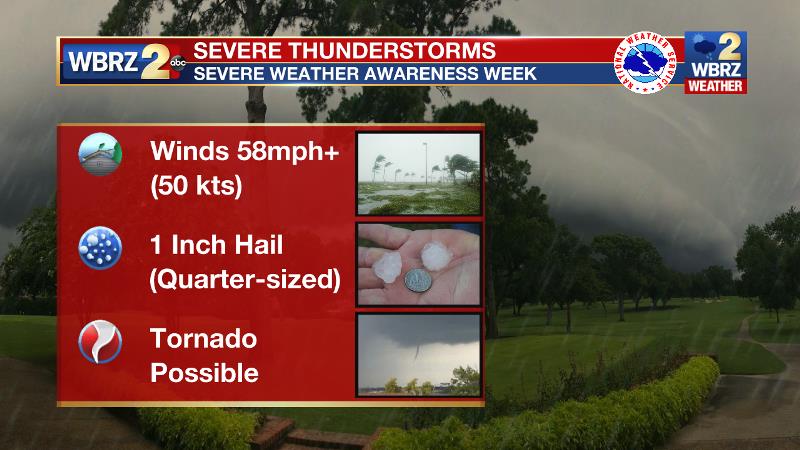What you should know: severe thunderstorms
A Severe Thunderstorm warning is issued when the National Weather Service detects a thunderstorm that is capable of producing wind gusts of in excess of 58 miles per hour or hail that is over one-inch in diameter. Severe Thunderstorms can even produce flash flooding and tornadoes. While lightning is certainly a serious danger, it is not part of the severe thunderstorm warning criteria. Out of data collected from 1950-2012, severe wind and hail occurred 9 times more often than tornadoes.

Severe Thunderstorms should never be taken lightly. Gusty thunderstorm winds can carve out an even larger, and sometimes more significant, damage path than tornadoes. Winds over 58mph can break off large branches, knock over trees or cause building damage. Large hail can damage crops, cars, homes, or worse, cause you serious injury.
So if a Severe Thunderstorm warning is issued, move inside of a sturdy structure for protection, preferably one that is enclosed to avoid lightning. Once inside, stay away from windows and electronics. Wait until the storm passes to go outside.

Stay ahead of severe weather; stay in touch with our weather team on Facebook and Twitter. For more on severe weather awareness week and severe weather safety, CLICK HERE.
Trending News
Before Severe Weather:
Be Weather-Ready: Check the forecast regularly to see if you're at risk for severe thunderstorms. Check in with WBRZ Channel 2 or NOAA Weather Radio to stay informed about severe thunderstorm watches and warnings. Check the Weather-Ready Nation for tips.
Sign Up for Notifications: Know how your community sends warning. Some communities have outdoor sirens. Others depend on media and smart phones to alert residents to severe storms.
Create a Communications Plan: Have a family plan that includes an emergency meeting place and related information. Pick a safe room in your home such as a basement, storm cellar or an interior room on the lowest floor with no windows. Get more ideas for a plan at: https://www.ready.gov/make-a-plan
Practice Your Plan: Conduct a family severe thunderstorm drill regularly so everyone knows what to do if a damaging wind or large hail is approaching. Make sure all members of your family know to go there when severe thunderstorm warnings are issued. Don't forget pets if time allows.
Prepare Your Home: Keep trees and branches trimmed near your house. If you have time before severe weather hits, secure loose objects, close windows and doors, and move any valuable objects inside or under a sturdy structure.
Help Your Neighbor: Encourage your loved ones to prepare for severe thunderstorms. Take CPR training so you can help if someone is hurt during severe weather.
During Severe Weather:
Stay Weather Ready: Acting quickly is key to staying safe and minimizing impacts. Continue to Check in with WBRZ Channel 2 or a NOAA Weather Radio to stay updated about severe thunderstorm watches and warnings.
At Your House: Go to your secure location if you hear a severe thunderstorm warning. Damaging wind or large hail may be approaching. Take your pets with you if time allows.
At Your Workplace or School: Stay away from windows if you are in a severe thunderstorm warning and damaging wind or large hail is approaching. Do not go to large open rooms such as cafeterias, gymnasiums or auditoriums.
Outside: Go inside a sturdy building immediately if severe thunderstorms are approaching. Sheds and storage facilities are not safe. Taking shelter under a tree can be deadly. The tree may fall on you. Standing under a tree also put you at a greater risk of getting struck by lightning.
In a Vehicle: Being in a vehicle during severe thunderstorms is safer than being outside; however, drive to closest secure shelter if there is sufficient time.
After Severe Weather
Stay Informed: Continue to check in with WBRZ Channel 2or a NOAA Weather Radio to stay updated about severe thunderstorm watches and warnings. More severe thunderstorms could be headed your way.
Contact Your Family and Loved Ones: Let your family and close friends know that you're okay so they can help spread the word. Text messages or social media are more reliable forms of communication than phone calls.
Assess the Damage: After you are sure the severe weather threat has ended, check your property for damages. When walking through storm damage, wear long pants, a long-sleeved shirt and sturdy shoes. Contact local authorities if you see power lines down. Stay out of damaged buildings. Be aware of insurance scammers if your property has been damaged.
Help Your Neighbor: If you come across people that are injured and you are properly trained, if needed, provide first aid to victims until emergency responders arrive.


